The OnePlus 3 Review
by Brandon Chester on June 20, 2016 8:00 AM EST- Posted in
- Smartphones
- OnePlus
- OnePlus 3
System Performance
2015 was not a great year for Android devices. Snapdragon 810’s problems with throttling severely crippled the performance of high end smartphones. In the case of the OnePlus 2, OnePlus went even farther by putting in code that would detect when Google Chrome was in use and completely shut off the A57 cluster on the SoC. This resulted in web browsing performance that was essentially no better than what you’d find on a $100 phone shipping with Snapdragon 410, which simply wasn’t acceptable given the fact that the OnePlus 2 was priced at around $400.
Like most of this year’s flagship Android devices, the OnePlus 3 uses Qualcomm’s Snapdragon 820 SoC. We looked at Snapdragon 820 not long ago in the LG G5 review and saw that it provided a substantial improvement over Snapdragon 810, which became even greater when you consider prolonged workloads where Snapdragon 810’s A57 cores throttle down and shut off. Given that OnePlus no longer has any reason to put in strange app detection code to manage thermals, we should see a good uplift in general performance and an enormous improvement in web performance.
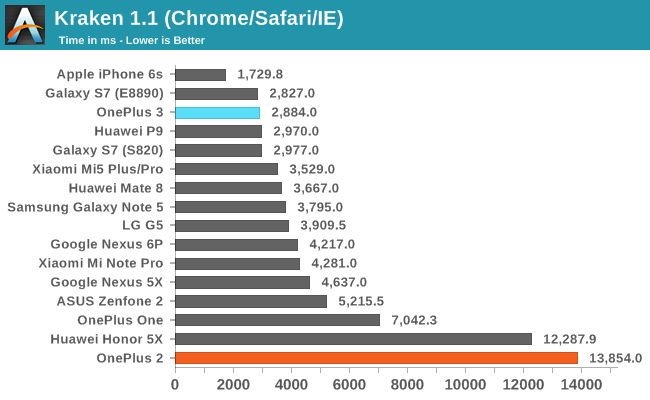
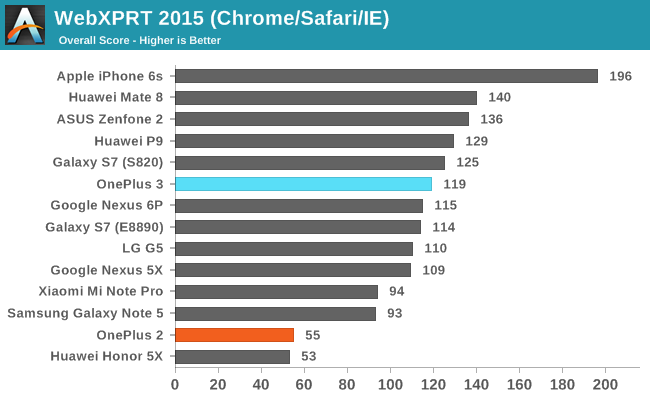
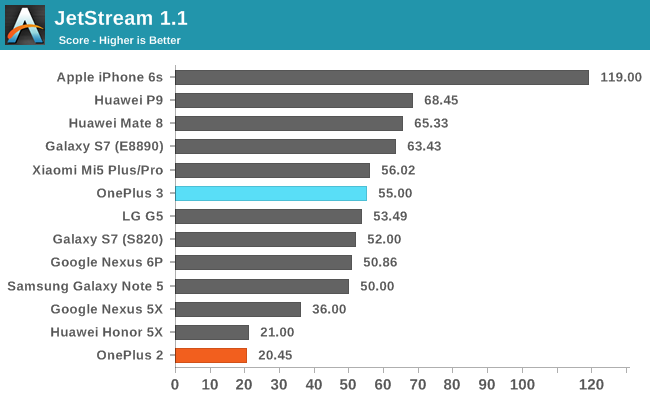
The improvement in web browsing performance when going from the OnePlus 2 to the OnePlus 3 is staggering. This isn't unexpected when you consider that the OnePlus 2 was just running on Cortex A53 cores that were meant for low power scenarios while the OnePlus 3 is using Qualcomm's Kryo cores. In Kraken the OnePlus 3 is over four times faster, while in WebXPRT and JetStream it's at least over two times faster. The OnePlus 2 actually represented a large regression in web performance compared to its predecessor, and OnePlus has brought web performance back to a level that is competitive with the other smartphones on the market with the OnePlus 3.

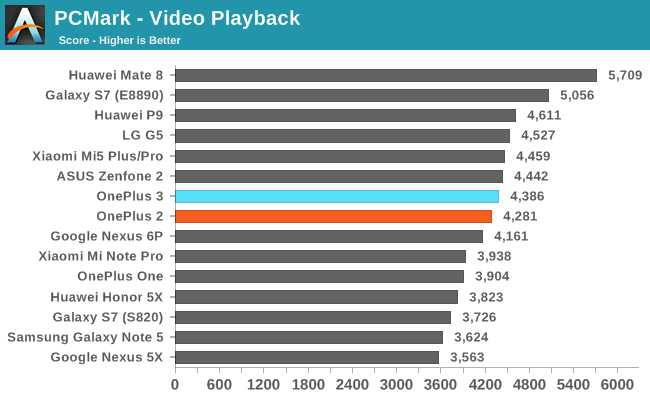

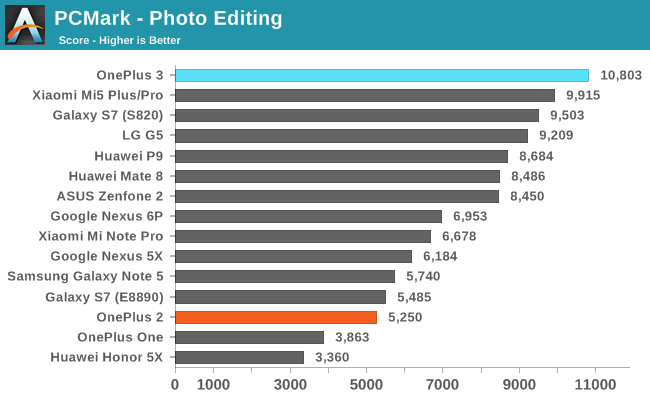
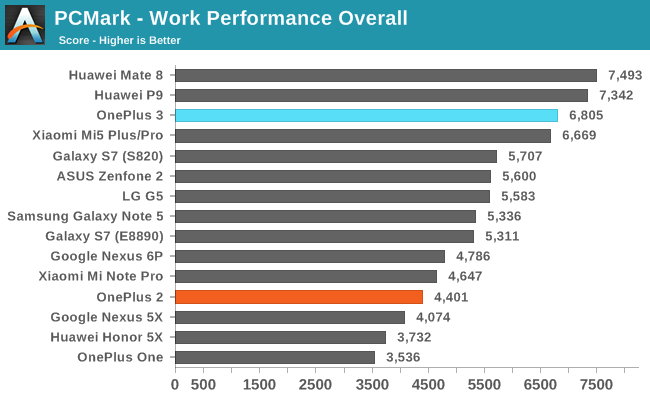
PCMark is an interesting test because it depends just as much on a phone's software as it does on the hardware. We've seen how devices with the same SoC can perform very differently, especially in certain sub-tests like the Writing and Photo Editing tests where different runtime and OS optimizations can have a large impact. The OnePlus 3 is no exception, with it achieving higher scores than the LG G5 in every test except for video playback where they have roughly the same scores.
This is not unexpected, as it was demonstrated in the LG G5 review that the G5 has more conservative frequency scaling than the other Snapdragon 820 devices that we've seen, which is reflected in PCMark's tests. In any case, the OnePlus 3 actually gets close to the Huawei Mate 8 in the writing test, and beats it and the LG G5 by a large margin in the photo editing test. In the end the OnePlus 3 places second on our overall chart, with only the Huawei Mate 8 ahead of it, and the gap between it and the Mate 8 being smaller than the gap between it and the Zenfone 2 which is the next fastest smartphone.
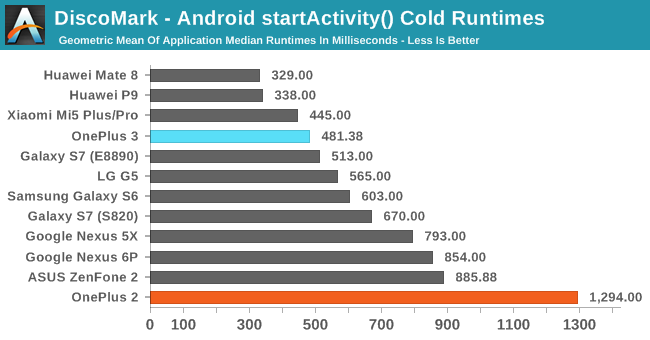
The OnePlus 3 is over two times faster than the OnePlus 2 with cold app launches where the application isn't resident in memory in any state. This is likely a combination of improved NAND performance, and changes to OnePlus's DVFS settings in addition to the performance improvements that Snapdragon 820 provides on its own. The impact that this has on the performance of the interface is significant, and when I reviewed the OnePlus 2 I noted how painfully slow it was to move around and through the applications. This new testing is a great example of that, with the OnePlus 2 taking 1.3 seconds just to launch apps, while the OnePlus 3 takes under 500ms and is the second fastest device here.
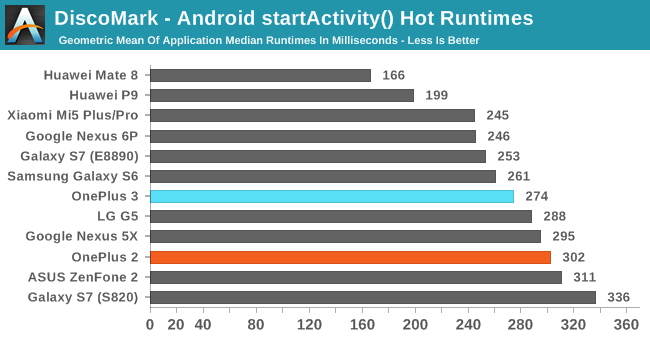
The OnePlus 3 improves a bit over the OnePlus 2 when resuming apps that are resident in memory, but not by a great deal. In general, all our devices hover between 250 and 300ms here, with the exception of the Huawei Mate 8 and P9 which are really in a category of their own for performance. While there's no enormous improvement here, the OnePlus 3 is competitive with other high end devices in the market, so there's nothing to complain about either.
One thing worth noting is that our set of apps wouldn't come close to utilizing the OnePlus 3's 6GB of RAM. Unfortunately, no matter how many apps we added, this would actually still be the case. The reason is that OnePlus has implemented very aggressive app eviction from memory, which means that your 6GB of RAM is really just sitting there using energy, and in general the utilization is pretty low. This may be a holdover from when the OnePlus 2 shipped in a 3GB configuration, but it's something OnePlus needs to address in a future OTA update. I'd imagine the Android enthusiast community is already at work on, or has already created custom kernels to alter this behavior as well. With 6GB of RAM you should be able to comfortably keep all of a user's frequently used apps resident in memory.
It's great to see that OnePlus is producing a smartphone with competitive performance once again. When the OnePlus One launched, Snapdragon 801 was the best you could get in an Android smartphone. The OnePlus 2 was an unfortunate victim of Snapdragon 810's heat and throttling problems, but OnePlus certainly didn't help the issue by hardcoding in mechanisms to detect Google Chrome and shut the A57 cluster off entirely. With the OnePlus 3 you get some of the best CPU performance in an Android phone, with PCMark's real-world tests demonstrating noticeable gains over the LG G5 which also uses Snapdragon 820. If I had to sum things up in a single line I'd just say that it's good to see that OnePlus is back in the game.


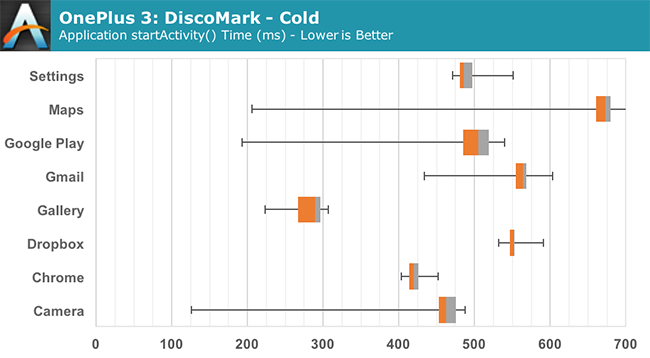
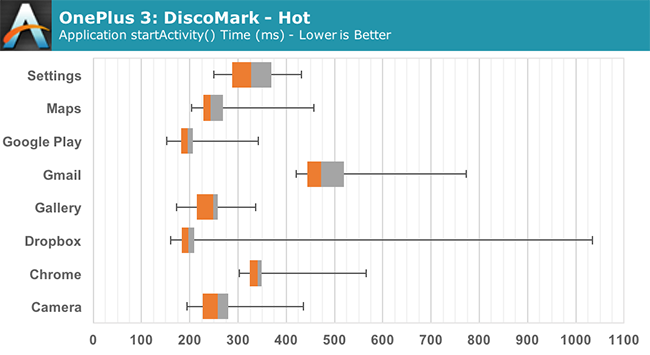








176 Comments
View All Comments
thek - Monday, June 20, 2016 - link
Regarding the last line - what I mean is that even if those companies flagships have slight bumps they should still be highly recommended for the sake of maybe making other big companies charge less for their phones (which they obv can do if this one costs 400$), or provide more for that same amount of money. They don't innovate because we just don't give them enough hard time for providing the same phone every year but with just more gimmicks, and not practical things like battery sizes and storage10basetom - Monday, June 20, 2016 - link
If they really want to help consumers save money, they should've gone with 3GB of RAM and keep the same $349 price tag. That extra 3GB is mostly for show at the moment (except maybe when you're playing 3D games).thek - Monday, June 20, 2016 - link
again, going for the one that tried to do something good.why not take the argument to apple for having only 2GB (or 1!!!!!) up until a year ago or to Samsung (and of course, Apple again) for keeping the batteries at a pathetic 2000-3000~ mark when they can provide much more if they wanted?
''why 6'' is a worse argument than ''why only 2''.
LukaP - Monday, June 20, 2016 - link
(speaking about ram now)Because, in case you havent noticed, the iPhones up until last year, didnt need more than a gig of ram, and still perform great with 2gigs, so why increase BOM and power usage for silly specs?
As for the batteries, these are very much parts that are dependent on the design of a phone. Sure they could slap in a 6000mAh battery into the next Galaxy, but then people like you, if not you, would be complaining here taht the phone is heavy and feels like a brick.
I personally dont have a problem with smaller batteries/ram amounts/resolutions if it doesnt compromise the user experience. and speaking from a perspective of an iPhone SE owner, the lower resolution screen is not noticable, the low battery capacity provides me more usable time than any Galaxy S device ive had before, and multitasking is faster and much less disruptive than it has ever been, despite "only" 2 gigs of RAM.
So why bash them for stupid "features"? Because either they could not include them, and save money, or not include them, adn spend that money on something that really matters, like a better screen, or atleast in factory calibration of what they have now.
UtilityMax - Monday, June 20, 2016 - link
The claim that iPhones like the 6, didn't need more than 1GB, even last year, is just BS. I had iphones with 1GB of RAM, and the apps and the tabs inside the web browsers kept reloading without any warning, sometimes losing data all the time. Yes, Apple did clever things to make sure the phone doesn't literally run out of memory, but multitasking was horrible. Moreover, It's truly ridiculous that a former flagship phone like iPhone 6 is no longer future proof, even though it's only two years old.Buk Lau - Monday, June 20, 2016 - link
there's a difference between "having 6GB of RAM" and "having 6GB but only limiting usage to something lower." what oneplus is doing is simply limiting RAM usage on the kernel level to something lower than 6; if that's the case, why have 6GB of RAM at all? what's the point if I pay for 6GB but can't use all of it at my will? oneplus said they are doing to save battery, but if that's the case why not just take off 2GB and use that money for a bigger battery? "why 6" isn't the argument here, it's "why 6 when only use 4?"melgross - Monday, June 20, 2016 - link
Because iOS functions differently. Android keeps apps open, and running, when you aren't using them, when they don't need to, absorbing RAM, processor cycles and battery power. Except for apps that need to do work in the background, iOS doesn't keep them open. Sometimes I have 50 apps in the que, but they're not actually open. The state of the apps are kept, and when we go to them again, it seems as though they were open.This is why iOS needs less RAM than Android.
UtilityMax - Wednesday, June 22, 2016 - link
But iOS keeps killing the apps and reloading the web browser tabs so aggressively that it really affects the usability. The 1GB iPhones are getting pretty much useless to me right now, because all they spend most of their time on, seemingly, is to reload the web browser tabs, silently, sometimes losing my data. I never run into such issues with the Android phones with 2GB of memory. What iOS did was simply a hack to hide the facts that iPhone 6 shipped with an inadequate amount of RAM.UtilityMax - Wednesday, June 22, 2016 - link
2-3GB of RAM is more than adequate. But 6GB is pretty much ridiculous. Ask any power-user or any price conscious user, and they would probably tell you that they would gladly trade the 3GB of Oneplus 3's RAM for better screen or an sd card slot or more battery life. 6GB is pretty much superflous at this point.LiverpoolFC5903 - Tuesday, June 21, 2016 - link
RAM is cheap though, as you can see by the glut of sub 300 USD phones from China with 3/4 GB RAM and weak processors. Even phones with a processor as weak as the Mt 6753 have 3GB at least these days. That extra 3 gb should no have added all that much to the bom, especially compared to the SOC and Display.Companies who gimp on RAM do it because they want to create sub segments and not because it adds a lot to the bom.
In any case, 2GB is more than sufficient for anything in Android, anything above is a waste. I dont need 100 apps in memory, no thanks. 6 GB is ridiculous overkill imho.